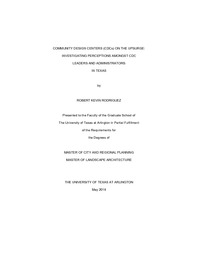| dc.description.abstract | For several decades, community design centers (CDCs) have specialized in professional design and planning assistance to non-profit groups, agencies, and individuals that lack the funding or resources to otherwise receive such services (ACD 2016). Notwithstanding the historical context under which CDCs were originally created, their persistent presence since the year 2000 has seen the number of CDCs nearly triple in North America, from just under 70, to "over 200 active organizations, covering ever-expanding geographic, disciplinary, and strategic territories" (ACSA 2014, 4). Yet, this growth aside, "CDCs remain a somewhat silent partner in the world of design" (Curry 2004, 70) with limited information regarding the spread of their practices nationwide.
The purpose of this research was to explore the recent surge of CDCs in North America. Specifically, by interviewing CDC leaders and administrators in Texas, this study sought answers to the question of why CDCs have experienced such increased growth across North America since the early 1990s. By studying the rise and decline of these organizations, through literature review, this pattern can historically be linked to the social, political, and economic conditions of the times (Castells 1983; Levy 2000; Sanoff 2000). Similarly, the current expansion of CDCs across North America may indicate a shift in any number of social, cultural, political, professional, or economic ideologies, yet to be determined. Therefore, from the vantage point of their administration, this study attempted to elucidate, from the perspective of CDC directors, the factors underlying the proliferation of CDCs in North America. The study explored economic, environmental, and social factors as possible causes of this growth. Furthermore, given the multi-disciplinary nature of community design, this study pursued to answer what roles do architecture, landscape architecture, and urban planning, play in the recent growth of CDCs nationwide.
Subjects of this research were leaders and administrators of CDCs in the state of Texas. Utilizing qualitative methods informed by the “research act” of John and Sharon Gaber (2007), this research was based on semi-structured interviews. It used open-ended questions to build upon the respondents' current knowledge of community design practices and of the growing number of CDCs across the nation. Through online searches and the review of public listings of registered U.S. nonprofits, these Texas leaders and administrators were identified and their contacts compiled from existing sources such as the Association for Community Design's member directory, and the Association of Collegiate Schools of Architecture's Community Design Directory. Information obtained from the interviews was analyzed to draw themes (Gaber and Gaber 2007; Taylor and Bogdan 1984) explaining the upsurge of CDCs and to gain insight regarding the continued spread of CDCs and their practices nationwide.
The findings of this research cited an increased economic, environmental, and social need for the services CDCs offer in Texas. Equally driving the growth of CDCs across the nation, an increased awareness of these perceived issues, along with an individual capacity and determination, proved influential not only in regards to CDC operations, but through educational outreach and an open appreciation for multi-disciplinary practices. | |


